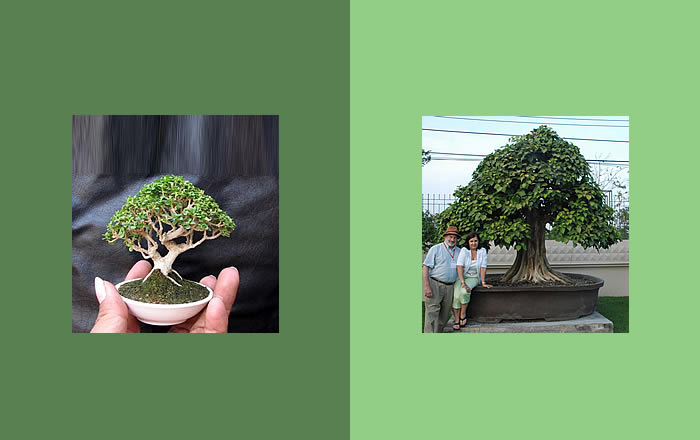One of the most convenient and memorable ways to measure the size of bonsai is by hands. That is, how many hands it takes to carry one.
Dai bonsai is a four or more handed bonsai. It takes two or more people to move it.
Chiu is a two handed bonsai.
Shohin is a one handed bonsai.
Shohin is further divided into sub categories: Komono (16″), Mame (5–10″) and Shito (fingertip bonsai, < 3″).
These size descriptions were originally used to design displays based on the size of tatami mats vs. the size of the trees, i.e. how big a room was needed for a tasteful display. We, and the Japanese too, have pretty well ignored this in recent years. So for us, the issues of size are of personal taste, space, handling, expense, and a couple of additional caveats.
Don’t imagine that small bonsai are somehow easier to make and keep—actually the opposite is true. In our high desert climate, the very act of adequate watering in spring and summer make small bonsai an overwhelming challenge for some, not to mention winter care. However, the ease of handling, the relatively lower cost involved in pots and stands, and the ability to have a number of plants in a small area, make the Shoin size very attractive. Shoin fans are a dedicated band of crazies, and are fiendishly loyal to their small world. Only this size generates numbers of specialized clubs and societies, both here and abroad.
Bonsai Master, John Naka has answered a thousand times the question: “How do I make good bonsai?” with “Aquire good material.” It’s less important for us to worry about size than it is to find good material in any size we feel we can handle fairly comfortably.
The ability to see possibility in raw material should generally not be limited by size concerns. Though the Shohin fans might throw some punches over that, the point is not to force preconceptions about size or anything else over your material like some kind of cookie cutter.
A good bonsai creates its own world around it, a world of mass, color, texture, line, and most important, of mood and emotional impact. If the tree has a touch of the magic, size does not matter.
When choosing a bonsai for size, areas of consideration are;
- How much time you can dedicate to your bonsai
- How much space you have available
- Your climate considerations
- Your budget
- Your level of experience
- Your physical strength or accessibility to assistance
In the end, do your research first and value the magic above the category. With just a basic knowledge of size differentiation, you should feel just as comfortable at the next happy hour as you are over a cup of your favorite tea.
